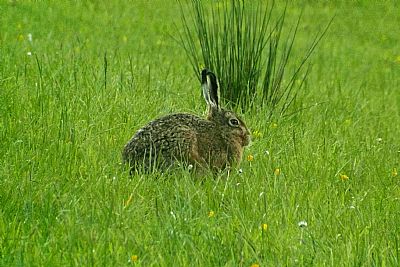RABBITS and HARES
RABBITS : Oryctolagus cuniculus
The rabbit is so ubiquitous with our countryside and even road verges, that you may be surprised to know that it was introduced to Britain.
They have certainly been hopping around us since medieval times and are thought to have been introduced from Europe after the Norman Conquest in 1066. But archaeological evidence now shows that the Romans may have been responsible. Excavations in Britain certainly show rabbit bones in their diet.
Although few of us consider eating rabbit these days, it used to be a regular part of our ancestor's diet. Visit many a historic home or larger house and you will invariably see it in the kitchen. Yet it still pops up on cookery programmes on tv.
Though few shops or butchers now sell it, it can still be found, particularly during the winter months. It can also be shot, snared or netted at any time of the year - something that many of us are disturbed by. Websites try to entice us by noting that rabbit meat is lean, nutritious, healthy, cheap or even for free.
Rabbits are important prey for larger birds of prey and mammals such as the larger birds of prey, the stoat and wildcat - and even domestic cats (although most will simply satisfy their hunting instincts and come home for packaged meat supper).
They may cause damage to crops and embankments, but they are also considered beneficial by maintaining some grassland habitats by providing open patches for small plants.


Rabbits in a farm field near Renton

And a rabbit on a lawn within the Lomond Industrial Estate

Black rabbits are a variation of the regular colouration.

This one is apparently a hybrid with a domestic rabbit.
SCOTTISH WILDLIFE TRUST : https://scottishwildlifetrust.org.uk/2017/04/the-european-rabbit/#:~:text=Despite%20their%20importance%2C%20it%20may%20then%20surprise%20you,by%20the%20aristocracy%20for%20their%20meat%20and%20fur.
SKY NEWS website : https://news.sky.com/story/rabbits-arrived-in-britain-1-000-years-earlier-than-thought-11696820
EUROPEAN HARE : Lepus europaeus
There are two species of hare in Scotland although you will only find one of them in West Dunbartonshire.
The hardy Mountain Hare is our only truly montane/arctic mammal and is mainly restricted to Scotland’s high ground. It is grey-brown in summer to blend with the heath and turns to white in winter, to match the snow. This is a truly indigenous species.
Our local hare is the Brown Hare or European Hare, as with the rabbit, an introduced species, presumed by the Romans. It is often a russet brown. Although sometimes confused with a rabbit, if encourtered close up its much larger size will be evident. It has very large ears and a black-and-white tail. It is often found in farmland, but also inhabits grassland or muirland. So well cammoflaged are they that many of us hardly see them when out walking - until suddenly disturbing them and they break cover with startling speed.
While we are accustomed to lots of small bunnies appearing in the spring, hares, being usually found alone and nocturnal, become quite a sight when we do come across them in a spring morning. The saying Mad as a March Hare becomes apparent. What appears as simply crazy behaviour is in fact them taking part in mating rituals, darting around at high speed in what appears random patterns, leaping in the air and even boxing each other.
It is usually the female landing the blows, fending off over amorous males. It is thought that this behaviour is also a test of strength and prowess by the males strength before proceeding with courtship. It is no surprise that the "March Hare" has entered the realm of fantasy such as by Lewis Carroll.
Hares live above ground in open country, usually hiding in long grass to escape predators, but once disturbed rely on outrunning their enemies. They reach speeds of 45 miles an hour, making them Britain's fastest land animal. Hares can also jump sideways and backwards over hedges to escape.
Brown hares declined in number during much of 20th century, mainly due to changes in farming practice. The current trend is less clear but the population appears to have stabilised.

A young hare meditates in the long grass of a field above Renton. At this age they look very much like rabbits, but their reddish brown fur and longer ears with black tips give them away. They also move slightly differently with long loping strides. The one above was photographed in May, but you may be lucky enough to see them in early spring when they go mad and run around with apparent pointlessness - mad as a March hare is a well known saying.

Possibly the same hare in the same spot a few months later.

A hare having a rain sprinkled green breakfast in early May.
THE WILDLIFE TRUSTS website : https://www.wildlifetrusts.org/wildlife-explorer/mammals/brown-hare

